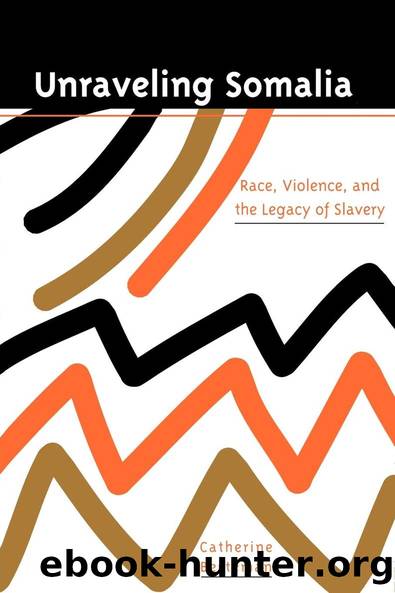Unraveling Somalia by Catherine Besteman

Author:Catherine Besteman [Besteman, Catherine]
Language: eng
Format: epub
ISBN: 9780812216882
Barnesnoble:
Publisher: University of Pennsylvania Press, Inc.
Published: 1999-05-07T00:00:00+00:00
Alternative Identities
Another aspect of ambiguity and resistance (and ambiguity in resistance) in local life was the nature of local identities. Colonial discourse, ethnographic descriptions, and the Somali popular imagination treated Gosha inhabitants as a âtribe,â an undifferentiated population defined as a group on the basis of a shared heritage of slavery. State kidnapping practices that targeted Gosha bodies for military service supported the popular conception of Gosha inhabitants as a separate and homogenous âgroup.â Gosha villagers met the homogenizing gaze of colonial authorities, the modern Somali state, and Somalist ethnographers with a variety of locally meaningful identities which contradicted their representation as âthe WaGosha.â The gulf between a âtribalâ representation and Gosha villagersâ conceptions of local identities reveals the divergence of structure and practice, certainty and ambiguity.
Far from imagining themselves as some kind of a âtribe,â the people who lived in the Gosha recognized differences and similarities among themselves according to a variety of criteria, which included clan affiliation, residence, affection, and ancestry. Gosha villagers were not interested in recognizing ethnic boundaries of the sort identified by Frederik Barth (1969), but rather strove to challenge the legitimacy of boundaries based on constructions of race, which they perceived as discriminatory rather than desirable. In other words, while recognizing their âracialâ distinctiveness within regional and national life, Gosha inhabitants looked to other facets of identity as more meaningful markers for social interaction in local, regional, and national arenas, using most of these markers to undermine notions of âraceâ or âethnicity.â
As discussed in previous chapters, within and between Gosha villages a vitally important aspect of identity was Somali clan affiliation. Clan membership provided an important basis (in theory) for residential patterns, for diya payment, for marriage transactions, and for personal identity. By their second year, toddlers were already being drilled in patrilineal âfamily history,â learning to recite their clan lines back to the founding Somali ancestor of their (adopted) clan-family. In my strolls through the village fields, I occasionally heard children, who were often charged with guarding their familiesâ farms against birds, pass the time by reciting their patrilineal clan names. One day a little girl, no more than four or five years old, ran crying through my compound to find her father because her fatherâs friends were teasing her by saying she wasnât a Bartire but rather an Ajuraan (which was her motherâs clan affiliation). Her father assured her that she was Bartire, and that his friends were just jesting with her in good fun.
By asserting their membership in Somali clans rather than their unity as a racially identifiable group, Gosha villagers resisted racial stereotyping and its accompanying ideological denigration. By claiming membership rights in Somali clans, Gosha people challenged the validity of race as the master symbol of group identity, demonstrating instead their right to transcend boundaries of race through their clan memberships.
At the same time, however, other aspects of identity muted or superseded the importance of clan affiliations (as well as a racialized identity) in villagersâ minds. In the practice
Download
This site does not store any files on its server. We only index and link to content provided by other sites. Please contact the content providers to delete copyright contents if any and email us, we'll remove relevant links or contents immediately.
| Central Africa | East Africa |
| North Africa | Southern Africa |
| West Africa | Algeria |
| Egypt | Ethiopia |
| Kenya | Nigeria |
| South Africa | Sudan |
| Zimbabwe |
Goodbye Paradise(2971)
Men at Arms by Terry Pratchett(2408)
Tobruk by Peter Fitzsimons(2064)
Pirate Alley by Terry McKnight(1910)
Arabs by Eugene Rogan(1838)
Borders by unknow(1789)
Belonging by Unknown(1472)
The Biafra Story by Frederick Forsyth(1326)
It's Our Turn to Eat by Michela Wrong(1305)
Botswana--Culture Smart! by Michael Main(1238)
A Winter in Arabia by Freya Stark(1225)
Gandhi by Ramachandra Guha(1196)
Coffee: From Bean to Barista by Robert W. Thurston(1183)
Livingstone by Tim Jeal(1152)
The Falls by Unknown(1142)
The Source by James A. Michener(1135)
The Shield and The Sword by Ernle Bradford(1101)
Egyptian Mythology A Fascinating Guide to Understanding the Gods, Goddesses, Monsters, and Mortals (Greek Mythology - Norse Mythology - Egyptian Mythology) by Matt Clayton(1088)
Africa: Altered States, Ordinary Miracles by Richard Dowden(1078)
